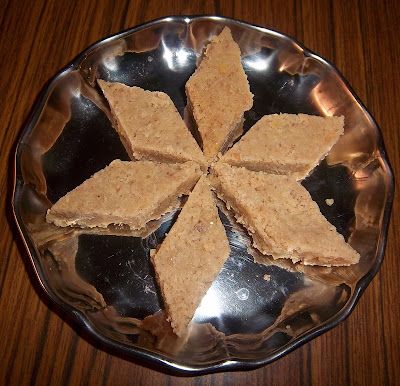This Coriander Chutney, I started preparing after tasting it in the restaurants and knowing the recipe from one of the neighbours, 25 years back.
Till then I used to prepare the other version called Thuvial, which is mostly made by all our family members.The thuvial is a solid form with minimum water content and stays for a longer time.
The chutney goes mainly well with the tiffin items like Idli, Dosa and Chappathi and variety rice.
Ingredients :
Coriander leaves ( Cleaned and Chopped ) 2 cups
Urad Dhal ( optional ) 1 tbsp.
Green chilly 2
Oil 2 tsp.
Grated coconut 2 tbsp.
Tamarind small piece
Hing, Salt
Method :
1. Soak the tamarind in warm water.
2. Heat little oil in a tawa and roast the urad dhal till it turns brown with an aroma.
3. Transfer the dhal to a plate and let it cool.In the same tawa, add little oil, add the
hing and then the green chillies and saute for a minute.Then add the coriander leaves
and saute well till the leaves shrink.Add the coconut and switch off Let them cool.
4. In a dry mixi, powder the roasted urad dhal coarsely.Then add the other ingredients
with the tamarind, salt and grind.Add some water and grind it coarsely as it is a
chutney. Seasoning with mustard and extra hing is purely optional.
Note :
1. Adding roasted Urad Dhal is also purely optional.Any roasted dhal gets powdered
well only if the mixi is dry.So whenever Urad or Channa dhal has to be added along
with the other ingredients in a mixi, normally we powder the dhal and add the other
ingredients.
2. Half cup of Urad Dhal can be roasted , cooled and powdered in a dry mixi coarsely.
This comes handy for any chutney and some dishes.
3. This chutney is tasty when taken fresh.So better to avoid storing in a fridge unless
it is left over.
Till then I used to prepare the other version called Thuvial, which is mostly made by all our family members.The thuvial is a solid form with minimum water content and stays for a longer time.
The chutney goes mainly well with the tiffin items like Idli, Dosa and Chappathi and variety rice.
 |
Coriander Chutney |
Ingredients :
Coriander leaves ( Cleaned and Chopped ) 2 cups
Urad Dhal ( optional ) 1 tbsp.
Green chilly 2
Oil 2 tsp.
Grated coconut 2 tbsp.
Tamarind small piece
Hing, Salt
Method :
1. Soak the tamarind in warm water.
2. Heat little oil in a tawa and roast the urad dhal till it turns brown with an aroma.
3. Transfer the dhal to a plate and let it cool.In the same tawa, add little oil, add the
hing and then the green chillies and saute for a minute.Then add the coriander leaves
and saute well till the leaves shrink.Add the coconut and switch off Let them cool.
4. In a dry mixi, powder the roasted urad dhal coarsely.Then add the other ingredients
with the tamarind, salt and grind.Add some water and grind it coarsely as it is a
chutney. Seasoning with mustard and extra hing is purely optional.
Note :
1. Adding roasted Urad Dhal is also purely optional.Any roasted dhal gets powdered
well only if the mixi is dry.So whenever Urad or Channa dhal has to be added along
with the other ingredients in a mixi, normally we powder the dhal and add the other
ingredients.
2. Half cup of Urad Dhal can be roasted , cooled and powdered in a dry mixi coarsely.
This comes handy for any chutney and some dishes.
3. This chutney is tasty when taken fresh.So better to avoid storing in a fridge unless
it is left over.



